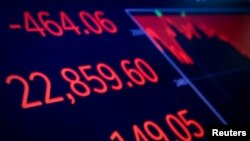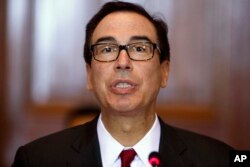It was another miserable day on Wall Street as a series of big December plunges continued, putting stocks on track for their worst month in a decade.
The Dow Jones Industrial Average dropped 464 points Thursday, bringing its losses to more than 1,700 points since Friday.
The benchmark S&P 500 index has slumped 10.6 percent this month and is almost 16 percent below the peak it reached in late September.
The steady gains of this spring and summer now fell like a distant memory. As we've entered the fall, investors started to worry that global economic growth is cooling off and that the U.S. could slip into a recession in the next few years. The S&P 500 is on track for its first annual loss in a decade.
The technology stocks that have led the market in recent years are now dragging it down. The technology-heavy Nasdaq composite is now down 19.5 percent from the record high it reached in August.
The market swoon is coming even as the U.S. economy is on track to expand this year at the fastest pace in 13 years. Markets tend to move, however, on what investors anticipate will happen well into the future, so it's not uncommon for stocks to sink even when the economy is humming along.
Slowing economy a concern
Right now, markets are concerned about the potential for a slowing economy and two threats that could make the situation worse: the ongoing trade dispute between the U.S. and China, which has lasted most of this year, and rising interest rates, which act as a brake on economic growth by making it more expensive for businesses and individuals to borrow money.
The selling in the last two days came after the Federal Reserve raised interest rates for the fourth time this year and signaled it was likely to continue raising rates next year, although at a slower rate than it previously forecast.
Scott Wren, senior global equity strategist at Wells Fargo Investment Institute, said investors felt Fed Chairman Jerome Powell came off as unconcerned about the state of the U.S. economy, despite deepening worries on Wall Street that growth could slow even more in 2019 and 2020. Wren said investors want to know that the Fed is keeping a close eye on the situation.
"He may be a little overconfident,'' said Wren. "The Fed needs to be paying attention to what's going on.''
Powell also acknowledged that the Fed's decisions are getting trickier because they need to be based on the most up-to-date figures on jobs, inflation, and economic growth. For the last three years the Fed told investors weeks in advance that it was almost certain to increase rates. But things are less certain now, and the market hates uncertainty
‘Completely overblown’
Treasury Secretary Steven Mnuchin said the market's reaction to the Fed was "completely overblown.''
Investors have responded to a weakening outlook for the U.S. economy by selling stocks and buying ultra-safe U.S. government bonds. The bond-buying has the effect of sending long-term bond yields lower, which reduces interest rates on mortgages and other kinds of long-term loans. That's generally good for the economy.
At the same time, the reduced bond yields can send a negative signal on the economy. Sharp drops in long-term bond yields are often seen as precursors to recessions.
The S&P 500 index skidded 39.54 points, or 1.6 percent, to 2,467.42. The Dow fell 464.06 points, or 2 percent, to 22,859.60 after sinking as much as 679.
The Nasdaq fell 108.42 points, or 1.6 percent, to 6,528.41. The Russell 2000 index of smaller companies dropped another 23.23 points, or 1.7 percent, to 1,326.
Stocks for smaller companies suffer
Smaller company stocks have been crushed during the recent market slump because slower growth in the U.S. will have an outsize effect on their profits. Relative to their size, they also tend to carry more debt than larger companies, which could be a problem in a slower economy with higher interest rates.
The Russell 2000 is down almost 24 percent from the peak it reached in late August and it's down 13.6 percent for the year to date. The S&P 500, which tracks larger companies, is down 7.7 percent.
The possibility of a partial shutdown of the federal government also loomed over the market on Thursday, as funding for the government runs out at midnight Friday. In general, shutdowns don't affect the U.S. economy or the market much unless they stretch out for several weeks, which would delay paychecks for federal employees.
Oil prices still dropping
Oil prices continued to retreat. Benchmark U.S. crude fell 4.8 percent to $45.88 a barrel in New York, and it's dropped 40 percent since early October. Brent crude, used to price international oils, slipped 5 percent to $54.35 a barrel in London.
After early gains, bond prices headed lower. The yield on the two-year Treasury rose to 2.87 percent from 2.65 percent, while the 10-year note rose to 2.80 percent from 2.77 percent.
The gap between those two yields has shrunk this year. When the 10-year yield falls below the two-year yield, investors call it an "inverted yield curve.'' That hasn't happened yet, but investors fear it will. Inversions are often taken as a sign a recession is coming, although it's not a perfect signal and when recessions do follow inversions in the yield curve, it can take a year or more.
"The bond market has been telling us something for about a year, and that is there's not going to be much inflation and there's not going to be a sustained surge in economic growth,'' said Wren, of Wells Fargo.
Around the world
In France, the CAC 40 lost 1.8 percent and Germany's DAX fell 1.4 percent. The British FTSE 100 slipped 0.8 percent. Indexes in Italy, Portugal and Spain took bigger losses.
Tokyo's Nikkei 225 lost 2.8 percent and Hong Kong's Hang Seng gave up 1 percent. Seoul's Kospi shed 0.9 percent.
As investors adjusted to the prospect of a weaker economy and lower long-term interest rates, the dollar fell to 111.11 yen from 112.36 yen. The euro rose to $1.1469 from $1.1368.
The British pound rose to $1.2671 from $1.2621. That sent the price of gold higher, and it gained 0.9 percent to $1,267.9 an ounce. Silver rose 0.3 percent to $14.87 an ounce and copper, which is considered an indicator of economic growth, fell 0.7 percent to $2.70 a pound.
Other fuel prices also fell. Wholesale gasoline lost 4.6 percent to $1.32 a gallon and heating oil slid 3.1 percent to $1.75 a gallon. Natural gas gave up 3.8 percent to $3.58 per 1,000 cubic feet.









